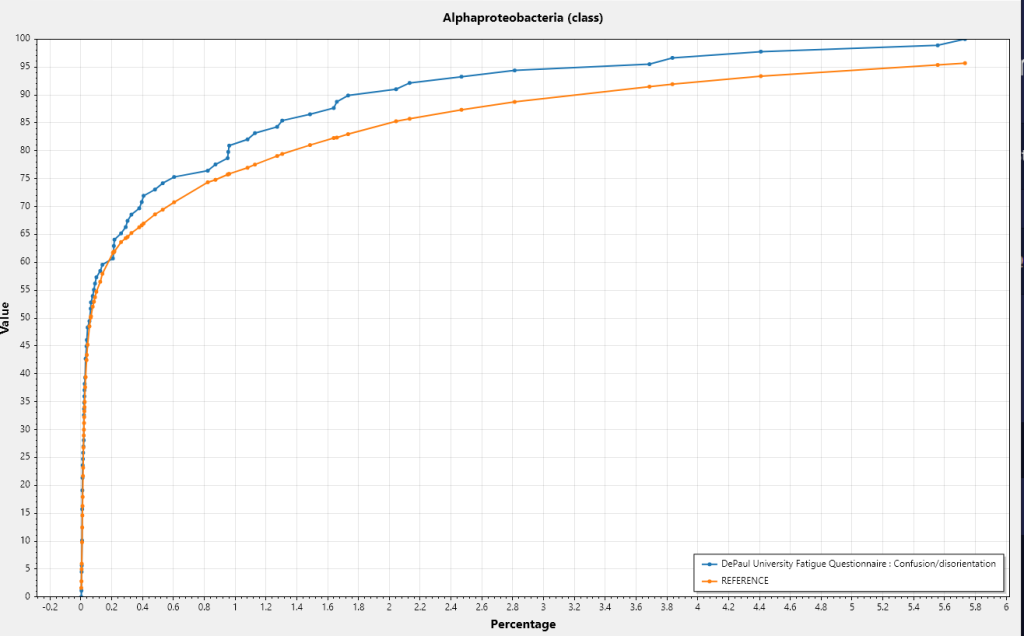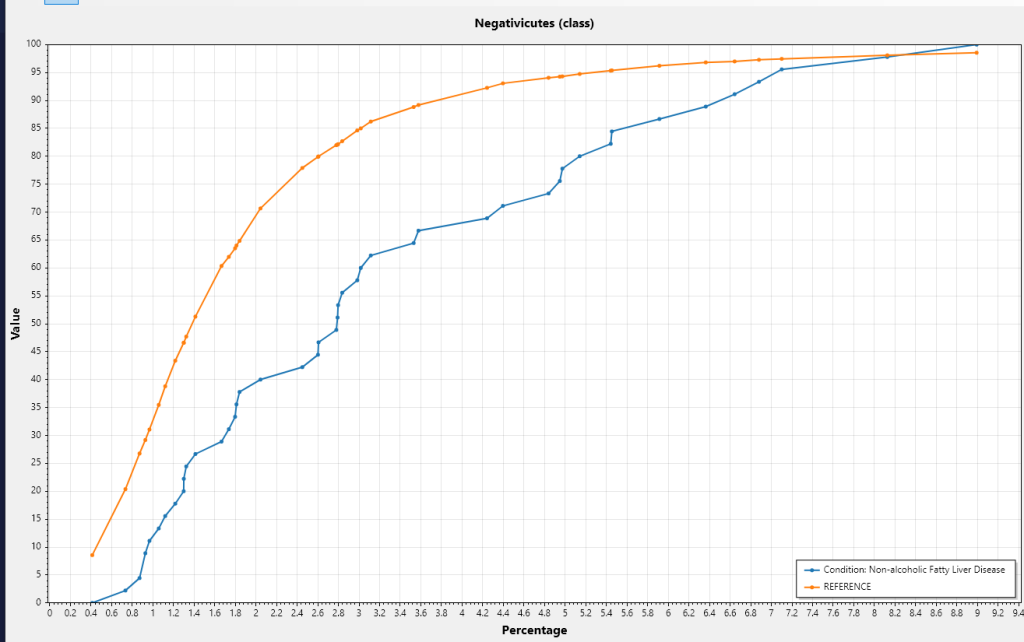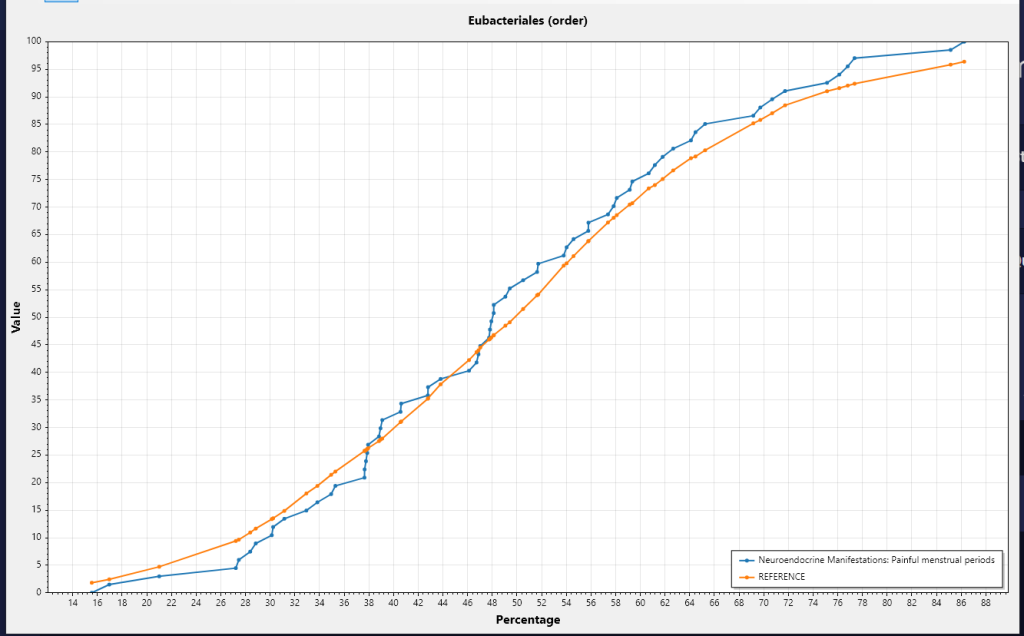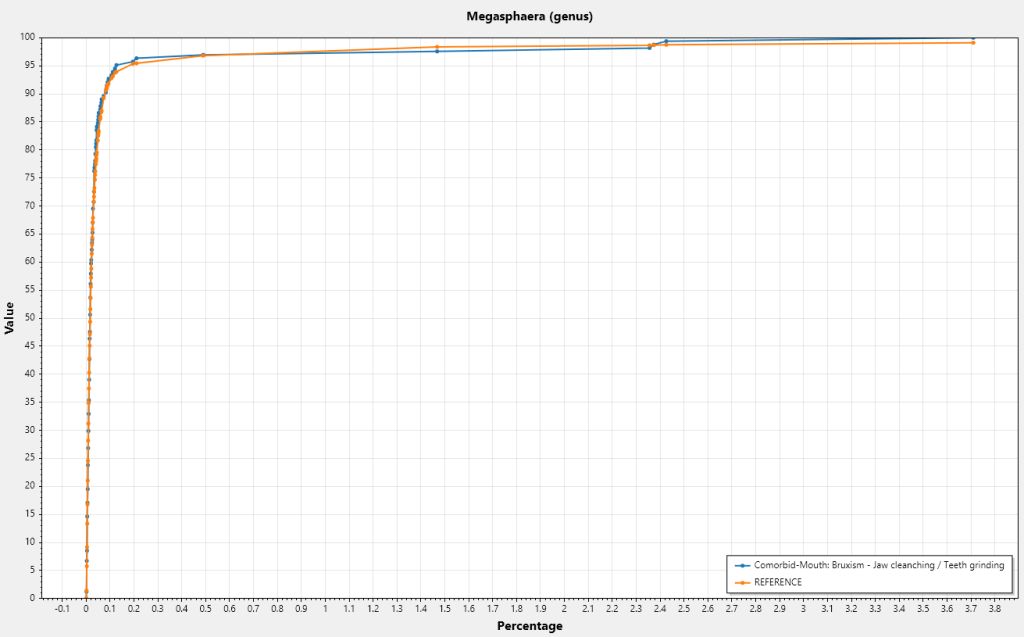This document presents the results of statistical analysis on symptoms from viable, self-annotated Biomesight microbiome samples. The methodology for data acquisition is outlined in New Standards for Microbiome Analysis?.
Tables have been refined to display only genus- and species-level taxa, the 20 most prominent entries per group, and associations achieving statistical significance (P < 0.01).
The following sections provide the processed data, accompanied by guidance on interpretation and application. Counts of significant bacterial taxa are included, reflecting the application of non-standard but rigorously validated statistical approaches to extensive sample and reference populations, where statistical power derives from dataset scale.
| Significance | Genus |
| p < 0.01 | 196 |
| p < 0.001 | 172 |
| p < 0.0001 | 154 |
| p < 0.00001 | 140 |
Averages and Medians
I prefer medians over averages. Medians are the values where half of the people have less and half has more. If the data was a bell-curve, then the values will almost be the same… with bacteria that happens rarely. Look at Bifidobacterium below, we see that the average is above and the median below.
If symptom median is higher than reference median, it means there is more of this bacteria. If lower, then less. This ignores how often the bacteria is seen (we average only over reports).
| tax_name | Rank | Symptom Avarage | Reference Average | Symptom Median | Reference Median |
| Bacteroides | genus | 28.802 | 25.926 | 24.224 | 27.059 |
| Phocaeicola | genus | 12.357 | 10.786 | 9.314 | 11.306 |
| Phocaeicola vulgatus | species | 7.043 | 5.751 | 3.394 | 4.929 |
| Bacteroides uniformis | species | 2.909 | 2.723 | 1.553 | 1.958 |
| Bacteroides thetaiotaomicron | species | 1.234 | 1.065 | 0.458 | 0.734 |
| Coprococcus | genus | 1.23 | 1.44 | 0.737 | 0.552 |
| Roseburia faecis | species | 0.969 | 1.217 | 0.577 | 0.455 |
| Bilophila | genus | 0.417 | 0.347 | 0.207 | 0.319 |
| Bifidobacterium | genus | 0.534 | 0.953 | 0.131 | 0.035 |
| Bacteroides stercoris | species | 2.066 | 1.543 | 0.033 | 0.123 |
| Blautia coccoides | species | 0.776 | 0.917 | 0.592 | 0.504 |
| Bilophila wadsworthia | species | 0.395 | 0.339 | 0.197 | 0.281 |
| Mediterraneibacter | genus | 0.885 | 0.708 | 0.278 | 0.326 |
| Butyricimonas | genus | 0.217 | 0.186 | 0.108 | 0.154 |
| Hathewaya | genus | 0.314 | 0.277 | 0.155 | 0.201 |
| Hathewaya histolytica | species | 0.314 | 0.277 | 0.155 | 0.201 |
| Bacteroides rodentium | species | 0.435 | 0.39 | 0.186 | 0.231 |
| Bifidobacterium longum | species | 0.237 | 0.326 | 0.051 | 0.012 |
| Lachnobacterium | genus | 0.197 | 0.327 | 0.075 | 0.041 |
| Bacteroides stercorirosoris | species | 0.234 | 0.191 | 0.135 | 0.164 |
Bacteria Incidence – How often is it reported
The common sense belief is that if a bacteria is reported more often, then the amount should be higher. This is often not true. The microbiome is a complex thing. Look at Bacteroides uniformis below, we see that the average is above and the median below
| tax_name | Rank | Incidence Odds Ratio | Chi2 | Symptoms % | Reference % |
| Bifidobacterium breve | species | 0.64 | 7.8 | 26.6 | 41.4 |
| Anaerococcus hydrogenalis | species | 1.66 | 7.2 | 18.2 | 11 |
More or Less often based on Symptom Median All Incidence
This is a little more complex to understand. If we compute the mid point for people with the symptom, then if the bacteria was not involved then half of the reference should be above this value and half below this value. If not, it means that the symptom tends to over or under growth.
| tax_name | Rank | Symptom Median | Odds Ratio | Chi2 | Below | Above |
| Niabella aurantiaca | species | 0.002 | 0.34 | 44.3 | 544 | 183 |
| Psychroflexus | genus | 0.002 | 0.31 | 43.7 | 357 | 111 |
| Psychroflexus gondwanensis | species | 0.002 | 0.31 | 43.7 | 357 | 111 |
| Rickettsia marmionii Stenos et al. 2005 | species | 0.002 | 0.33 | 41.6 | 398 | 131 |
| Psychrobacter glacialis | species | 0.002 | 0.37 | 38.6 | 660 | 246 |
| Niabella | genus | 0.002 | 0.38 | 36 | 584 | 222 |
| Chromatium | genus | 0.002 | 0.38 | 34.4 | 517 | 198 |
| Chromatium weissei | species | 0.002 | 0.38 | 34.2 | 516 | 198 |
| Lentibacillus | genus | 0.002 | 0.38 | 34 | 510 | 196 |
| Lentibacillus salinarum | species | 0.002 | 0.38 | 33.7 | 494 | 190 |
| Viridibacillus neidei | species | 0.002 | 0.38 | 33.3 | 469 | 180 |
| Thermoanaerobacterium | genus | 0.002 | 0.41 | 30 | 483 | 196 |
| Thiomicrospira | genus | 0.002 | 0.39 | 29.3 | 335 | 130 |
| Sporosarcina pasteurii | species | 0.002 | 0.41 | 29.2 | 439 | 178 |
| Thiorhodococcus | genus | 0.002 | 0.42 | 29.1 | 578 | 243 |
| Thermoanaerobacterium islandicum | species | 0.002 | 0.41 | 29 | 476 | 196 |
| Syntrophomonas sapovorans | species | 0.002 | 0.42 | 29 | 534 | 223 |
| Sporosarcina | genus | 0.002 | 0.42 | 27.5 | 443 | 185 |
| Thermodesulfovibrio thiophilus | species | 0.002 | 0.44 | 25.5 | 536 | 237 |
| Oenococcus | genus | 0.002 | 0.45 | 24.8 | 604 | 273 |
More or Less often based on Reference Median All Incidence
This is like the above, but with a different line in the sand. Instead of the median of those with the condition, we use the median of the reference set.
| tax_name | Rank | Reference Median | Odds Ratio | Chi2 | Below | Above |
| Bifidobacterium longum | species | 0.012 | 2.27 | 260.2 | 870 | 1971 |
| Bifidobacterium | genus | 0.035 | 2.04 | 241.7 | 1266 | 2586 |
| Methylobacillus glycogenes | species | 0.003 | 0.4 | 232.5 | 1250 | 497 |
| Methylobacillus | genus | 0.003 | 0.41 | 217.2 | 1249 | 516 |
| Corynebacterium | genus | 0.0085 | 0.42 | 201.9 | 1163 | 486 |
| Bilophila | genus | 0.3185 | 0.55 | 162.8 | 2247 | 1236 |
| Erysipelothrix muris | species | 0.015 | 0.55 | 161 | 2153 | 1179 |
| Psychrobacter glacialis | species | 0.002 | 0.37 | 156.5 | 660 | 246 |
| Niabella aurantiaca | species | 0.002 | 0.34 | 153.5 | 544 | 183 |
| Methylonatrum | genus | 0.004 | 0.53 | 145.2 | 1620 | 866 |
| Methylonatrum kenyense | species | 0.004 | 0.53 | 145.2 | 1620 | 866 |
| Catonella morbi | species | 0.01 | 0.56 | 144 | 1968 | 1099 |
| Catonella | genus | 0.01 | 0.56 | 141.4 | 1966 | 1104 |
| Erysipelothrix | genus | 0.0155 | 0.57 | 139.9 | 2151 | 1232 |
| Niabella | genus | 0.002 | 0.38 | 137 | 584 | 222 |
| Megasphaera elsdenii | species | 0.0045 | 0.41 | 132.7 | 640 | 260 |
| Bacteroides thetaiotaomicron | species | 0.734 | 0.6 | 130.1 | 2389 | 1422 |
| Veillonella parvula | species | 0.003 | 1.9 | 128.6 | 666 | 1266 |
| Alkalithermobacter paradoxus | species | 0.004 | 0.55 | 125.8 | 1537 | 853 |
| Odoribacter denticanis | species | 0.005 | 0.57 | 124.1 | 1642 | 928 |
More or Less often based on Symptom Median High Incidence
Above we see that many of the top bacteria identified are sparse, that is not reported often. We then restrict them to those that occur above 50% or the time.
| tax_name | Rank | Symptom Median Freq | Odds Ratio | Chi2 | Below | Above |
| Clostridium taeniosporum | species | 0.003 | 0.61 | 11.2 | 1344 | 814 |
| Dethiosulfovibrio | genus | 0.004 | 0.66 | 7.6 | 1500 | 994 |
| Tetragenococcus doogicus | species | 0.003 | 0.67 | 7.2 | 1360 | 910 |
More or Less often based on Reference Median High Incidence
Above we see that many of the top bacteria identified are sparse, that is not reported often. We then restrict them to those that occur above 50% or the time.
| tax_name | Rank | Reference Median Freq | Odds Ratio | Chi2 | Below | Above |
| Bifidobacterium longum | species | 0.012 | 2.27 | 260.2 | 870 | 1971 |
| Bifidobacterium | genus | 0.035 | 2.04 | 241.7 | 1266 | 2586 |
| Methylobacillus glycogenes | species | 0.003 | 0.4 | 232.5 | 1250 | 497 |
| Methylobacillus | genus | 0.003 | 0.41 | 217.2 | 1249 | 516 |
| Corynebacterium | genus | 0.0085 | 0.42 | 201.9 | 1163 | 486 |
| Bilophila | genus | 0.3185 | 0.55 | 162.8 | 2247 | 1236 |
| Erysipelothrix muris | species | 0.015 | 0.55 | 161 | 2153 | 1179 |
| Psychrobacter glacialis | species | 0.002 | 0.37 | 156.5 | 660 | 246 |
| Niabella aurantiaca | species | 0.002 | 0.34 | 153.5 | 544 | 183 |
| Methylonatrum | genus | 0.004 | 0.53 | 145.2 | 1620 | 866 |
| Methylonatrum kenyense | species | 0.004 | 0.53 | 145.2 | 1620 | 866 |
| Catonella morbi | species | 0.01 | 0.56 | 144 | 1968 | 1099 |
| Catonella | genus | 0.01 | 0.56 | 141.4 | 1966 | 1104 |
| Erysipelothrix | genus | 0.0155 | 0.57 | 139.9 | 2151 | 1232 |
| Niabella | genus | 0.002 | 0.38 | 137 | 584 | 222 |
| Megasphaera elsdenii | species | 0.0045 | 0.41 | 132.7 | 640 | 260 |
| Bacteroides thetaiotaomicron | species | 0.734 | 0.6 | 130.1 | 2389 | 1422 |
| Veillonella parvula | species | 0.003 | 1.9 | 128.6 | 666 | 1266 |
| Alkalithermobacter paradoxus | species | 0.004 | 0.55 | 125.8 | 1537 | 853 |
| Odoribacter denticanis | species | 0.005 | 0.57 | 124.1 | 1642 | 928 |
Summary
A large number of bacterial taxa exhibit shifts with P < 0.01 in association with this condition. The subsequent challenge is determining how to modulate these taxa, since the volume of candidates exceeds what most individuals can practically consider. Moreover, for many of the taxa identified, there is no published evidence in the U.S. National Library of Medicine describing how to alter their abundance.
A deep optimization model, such as the one implemented on the Microbiome Taxa R2 site, can be used to inform probiotic selection. This model provides coverage for each identified taxon and infers which probiotics are most likely to shift their levels. Its output may then be integrated with more conventional recommendations derived from literature indexed in the U.S. National Library of Medicine where such evidence exists, with the two recommendation sets reconciled by giving priority to probiotic-based suggestions.
Development of a dedicated database based on Biomesight samples is in progress. The current model uses data contributed by PrecisionBiome, and datasets generated with differing laboratory processing pipelines cannot be safely combined, as discussed in The taxonomy nightmare before Christmas…. Once the Biomesight-specific database is complete, an option for generating (offline-only) personalized suggestions will be added to the Microbiome Prescription website.
Probiotics Suggestions
The following are based on a simplified algorithm using R2 data for Biomesight. These are tentative numbers subject to future refinements. Bacteria listed are only for probiotics detected with Biomesight tests. Probiotics include some that are available only in some countries and some that are pending approval for retail sale.
- Good Count: Number of bacteria expected to shift in desired direction
- Bad Count: Number of bacteria expected to shift in wrong direction
- Impact: Estimator of impact based on Chi-2, Slope and R2 vectors
Some literature suggesting that the model’s suggestions are reasonable:
- Bifidobacterium breve Bif11 supplementation improves depression-related neurobehavioural and neuroinflammatory changes in the mouse. Neuropharmacology (Neuropharmacology ) Vol: 229 Issue: Pages: 109480 Pub: 2023 May 15 ePub: 2023 Mar 1 Authors Sushma G,Vaidya B,Sharma S,Devabattula G,Bishnoi M,Kondepudi KK,Sharma SS
- Heat-sterilized Bifidobacterium breve prevents depression-like behavior and interleukin-1ß expression in mice exposed to chronic social defeat stress. Brain, behavior, and immunity (Brain Behav Immun ) Vol: Issue: Pages: Pub: 2021 May 29 ePub: 2021 May 29 Authors Kosuge A,Kunisawa K,Arai S,Sugawara Y,Shinohara K,Iida T,Wulaer B,Kawai T,Fujigaki H,Yamamoto Y,Saito K,Nabeshima T,Mouri A
- Bifidobacterium breve BB05 alleviates depressive symptoms in mice via the AKT/mTOR pathway.
Frontiers in nutrition (Front Nutr ) Vol: 12 Issue: Pages: 1529566 Pub: 2025 ePub: 2025 Jan 30 Authors Pan Y,Huang Q,Liang Y,Xie Y,Tan F,Long X - Lipid and Energy Metabolism of the Gut Microbiota Is Associated with the Response to Probiotic Bifidobacterium breve Strain for Anxiety and Depressive Symptoms in Schizophrenia.
Journal of personalized medicine (J Pers Med ) Vol: 11 Issue: 10 Pages: Pub: 2021 Sep 30 ePub: 2021 Sep 30 Authors Yamamura R,Okubo R,Katsumata N,Odamaki T,Hashimoto N,Kusumi I,Xiao J,Matsuoka YJ - Towards a psychobiotic therapy for depression: Bifidobacterium breve CCFM1025 reverses chronic stress-induced depressive symptoms and gut microbial abnormalities in mice. Neurobiology of stress (Neurobiol Stress ) Vol: 12 Issue: Pages: 100216 Pub: 2020 May ePub: 2020 Mar 20 Authors Tian P,O’Riordan KJ,Lee YK,Wang G,Zhao J,Zhang H,Cryan JF,Chen W
| Probiotic Species | Impact | Good Count | Bad Count |
| Faecalibacterium prausnitzii | 256.62 | 8 | 0 |
| Blautia hansenii | 181.61 | 22 | 1 |
| Bifidobacterium breve | 89.17 | 15 | 0 |
| Bifidobacterium longum | 79.15 | 15 | 2 |
| Blautia wexlerae | 59.88 | 7 | 0 |
| Bifidobacterium adolescentis | 58.57 | 14 | 2 |
| Segatella copri | 41.79 | 3 | 0 |
| Bifidobacterium bifidum | 17.98 | 11 | 2 |
| Bifidobacterium catenulatum | 15.57 | 8 | 0 |
| Escherichia coli | 14.66 | 11 | 0 |
| Enterococcus faecalis | 14.27 | 42 | 46 |
| Akkermansia muciniphila | 11.57 | 12 | 9 |
| Lactobacillus helveticus | 9.86 | 43 | 53 |
| Bifidobacterium animalis | 8.17 | 7 | 0 |
| Enterococcus faecium | 5.05 | 14 | 34 |
| Streptococcus thermophilus | 2.3 | 4 | 0 |
| Enterococcus durans | 2.14 | 25 | 23 |
| Veillonella atypica | 1.34 | 12 | 0 |
| Clostridium butyricum | 0.67 | 13 | 26 |
| Bacillus subtilis | 0.51 | 28 | 33 |
| Lacticaseibacillus paracasei | 0.23 | 13 | 5 |
| Lactococcus lactis | 0.15 | 2 | 5 |
| Limosilactobacillus fermentum | 0.12 | 10 | 17 |
| Lactiplantibacillus pentosus | 0.1 | 6 | 4 |
| Heyndrickxia coagulans | 0.04 | 8 | 14 |
| Ligilactobacillus salivarius | -0.05 | 2 | 10 |
| Lactiplantibacillus plantarum | -0.08 | 3 | 6 |
| Lacticaseibacillus casei | -0.17 | 1 | 10 |
| Lacticaseibacillus rhamnosus | -0.18 | 2 | 5 |
| Limosilactobacillus vaginalis | -0.22 | 25 | 51 |
| Leuconostoc mesenteroides | -0.26 | 4 | 13 |
| Bifidobacterium pseudocatenulatum | -0.35 | 7 | 24 |
| Lactobacillus crispatus | -0.63 | 2 | 31 |
| Limosilactobacillus reuteri | -0.78 | 17 | 22 |
| Lactobacillus acidophilus | -0.83 | 5 | 33 |
| Odoribacter laneus | -1.78 | 0 | 3 |
| Lactobacillus jensenii | -3.23 | 18 | 55 |
| Pediococcus acidilactici | -7.22 | 26 | 33 |
| Lactobacillus johnsonii | -13.52 | 36 | 39 |
| Parabacteroides goldsteinii | -21.27 | 0 | 13 |
| Parabacteroides distasonis | -27.34 | 0 | 11 |
| Bacteroides uniformis | -285.55 | 0 | 11 |
| Bacteroides thetaiotaomicron | -294.72 | 0 | 10 |










Recent Comments